Christine Valters Paintner's Blog, page 81
April 27, 2019
Cultivating Eyes of the Heart (Part 3) ~ A Love Note from Your Online Abbess
 Dearest monks, artists, and pilgrims,
Dearest monks, artists, and pilgrims,
Photography is an especially accessible art medium in our modern world, where almost everyone carries a camera built into their phone, or small, portable cameras with good picture quality are widely available. In my book, Eyes of the Heart: Photography as a Christian Contemplative Practice, I suggest ways to engage your camera as a tool for prayer and to cultivate a different way of seeing the world.
We talk in our culture a lot about taking photos or even capturing and shooting. Cultivating “eyes of the heart” (Ephesians 1:18) refers to a kind of graced vision that is focused more on receiving gifts. Seeing in this way is different from our ordinary way of scanning our field of vision for the information we want to find. Instead, it is a spacious gaze which savors each moment.
In the Benedictine monastic tradition, everything is considered sacred. The stranger at the door is to be welcomed in as Christ. The kitchen utensils are to be treated just like the altar vessels. The hinges of the day call us to remember the presence of God again and again, so that time becomes a cascade of prayers.
Photography can become an act of deepened awareness and love. We can begin to see the everyday things of our lives as openings into the depth dimension of the world: the bird singing from a tree branch outside my window, the doorbell announcing a friend’s arrival, the meal which nourishes my body for service. Each of these moments invites us to pause and to see it through a different kind of vision.
Call to mind a time when you were so present to the moment, to the sheer grace of things. Then the thoughts broke in which seemed to wield only criticism and dissatisfaction. Maybe you remember the items still languishing on your “to do” list back at home and you felt an anxious dread. Contemplative practice cultivates our awareness of this pattern, so that we might be able to change it. We can become aware of our thoughts and gently release them. When moments come to visit us, we are then able to savor and bask in wonder rather than reach for what is next.
Contemplative practice also cultivates our profound awareness of life as an unending stream of gifts. From this arises the impulse to create. When we open ourselves to the sheer grace of things, we tap into a source of inspiration. We feel moved to create something out of that gratitude.
For me, the creative practice of photography can be a powerful doorway into transformed seeing. When we open ourselves to receiving photos, rather than taking them, we are offered a gift. By bringing the camera to the eye and allowing an encounter with the holy to open our hearts, we might be transformed.
Look through the lens and imagine that it is a portal to a new way of seeing. Let the focus of the frame bring your gaze to the quality of light in this moment or the vibrancy of colors. Pay attention to what is shimmering. Even five minutes can shift your gaze to a deepened quality of attentiveness. No need to capture everything you see, but simply an invitation to breathe in the beauty of this moment.
Let yourself be willing to see the world differently, so that what others miss in the rush of life becomes transfigured through your openness and intention. This practice invites us to walk along the road and pay close attention, make space to receive the gift of bread, the nourishment of conversation, and a vision of the sacred.
For me, photography and writing are the ways I feel most often moved to respond to the generosity of life. Try this next time you feel overcome by beauty — pause there as long as you can without moving to do something else or complete another task. And then, when there is a sense of fullness or completion, pick up a camera or a pen, and allow them to become the tools to honor what you have experienced and your expression of deep gratitude. Rather than “capturing” the encounter, let this be a prayer, so that slowly over time you might find yourself in an unending litany of praise.
You can read Part One here and Part Two here.
(This reflection first appeared in an issue of Weavings journal)
Please join us for our Easter season online retreat when we will practice resurrection through contemplative photography. Our journey begins tomorrow! Details and registration here>>
We are also approaching the feast of Beltaine in the northern hemisphere and Samhain in the southern hemisphere.
With great and growing love,
Christine
Christine Valters Paintner, PhD, REACE
Photo © Christine Valters Paintner
April 23, 2019
Monk in the World Guest Post: Mary Van Denend
I am delighted to share another beautiful submission to the Monk in the World guest post series from the community. Read of for Mary Van Denend's post "Girls in the Trees."
My granddaughters are playing “jungle,” scrambling up branches as high as they dare go, in a leafy playground tree, fat as a hot air balloon. We’ve exhausted the slides, the swings, the merry-go-round, the balance beams, and me. It’s only April but the day has turned unseasonably warm. The tree’s shade offers coolness.
Lucia, the youngest, screeches from her perch in a red and purple peasant dress we just purchased at Good Will. “Look, I’m a baby monkey! I’m a baby monkey!”, she chatters in a high pitch. At four, she’s charming and fearless; always choosing the highest slide, the fastest swing, always wanting the top bunk at home.
Elsa, with hazel eyes and hair like dark honey, middle child of moods and shadows, hides, then clambers, then hides again. Her lanky limbs in navy leggings camouflage her movements so I can’t tell what’s branch and what’s leg. Their doctor says she’ll be 5’9’’ or 10”, maybe taller. She’s more leopard than monkey, stealthy and shy.
Anneke vacillates midway up. At eleven, she could easily reach the upper branches, but she’s hot and tired, eager for promised hot dogs back at the house. She’s dressed like a tropical bird today in blues, teals, and deep pink. Her ponytail a plume of golden feathers. Last summer she broke her foot jumping off a stone wall, and spent the next 8 weeks in a cast—she who loves to swim. Maybe that’s part of her hesitance.
*****
When I was a kid I used to watch Tarzan movies with Johnny Weissmuller. I loved it when Jane would come swinging through the trees too, and they’d meet somewhere at a secret landing. She often had a chimp in her arms and could still fly like an acrobat through the canopy, on a single thick vine. I thought Jane was amazing.
Climbing trees was a big part of my childhood. Though never much of an athlete, I had good balance and wasn’t afraid to keep going higher, as long as I had a footing on something secure. The world looks different from inside a tree, no matter how high up. It’s cool and green, rustling and rough; it’s a patchwork of light and patterns, smelling mossy or sweet. You can peer over rooftops or at the peeling bark right in front of you.
Perhaps that’s one reason I love to visit monasteries. They’re often set in beautiful places surrounded by trees. Some create walking paths that lead visitors through gentle woods, to quiet corners for contemplation and prayer. One such place, a Cistercian community about an hour and a half north, allows lay “monks” like me to peacefully wander and breathe in the forest. Others may employ members as laborers who work in fruit or nut orchards as part of their communal life. We live in hazelnut country.
One summer in my early twenties I worked on an apple orchard in Wenatchee, Washington owned by friends. For six weeks every day, starting at 8:00 am, we picked apples and cherries until noon, and then again late in the day. It was blazing hot inside those trees. Sap stuck to my hair and bees (which I’m mildly allergic to) buzzed over me. My arms ached from stretching way beyond my normal reach to grab a perfect Golden Delicious or Gravenstein. At the end of each day I was exhausted, but proud of myself too. I’ve never done anything like that before or since. It was also the summer I read the Lord of the Rings trilogy for the first time, on the recommendation of my landlords. Now I can’t think of Tolkien without thinking about that orchard and those trees. Without romanticizing the itchy skin and sore muscles, that summer I felt strong and brave.
*****
I wonder if kids climb trees the way we used to anymore. Sadly, I kind of doubt it. Too many indoor distractions—cell phones, video games, 150 TV channels. Now there are miniature climbing walls on many playgrounds, including the one near my house, and rock climbing courses through local Parks & Rec. All of which can be a good thing for building confidence and coordination, for learning about teamwork and trust.
But there’s nothing quite like finding yourself under a quilt of leaves in the fork of a sweetgum in Fall, surrounded by bright red stars. Or gathering cones from the thick candelabra arms of a Sitka spruce, breathing an evergreen story into your lungs. And you, you’re the one who climbed there by your own strength and wits. What I hope my three granddaughters will remember when they’re teenagers and beyond: there’s a place you can go where the world grows quiet and serene; there’s a branch somewhere waiting for you, where a goldfinch might be hiding, where the leaves whisper your name.
 Mary Van Denend makes her home in Oregon’s lush Willamette Valley, though her childhood was very nomadic. She’s a poet and essayist, with a MFA in Creative Writing (Seattle Pacific), and the author of a chapbook, Watermarks, and many other publications. She’s a contemplative in spirit and a wanderer by heart. She loves to read, cook, hike, travel, and paint.
Mary Van Denend makes her home in Oregon’s lush Willamette Valley, though her childhood was very nomadic. She’s a poet and essayist, with a MFA in Creative Writing (Seattle Pacific), and the author of a chapbook, Watermarks, and many other publications. She’s a contemplative in spirit and a wanderer by heart. She loves to read, cook, hike, travel, and paint.
April 20, 2019
Easter Blessings + Take My Hand (new poetry video) ~ A Love Note from Your Online Abbess
Take My Hand
Please don’t plant me
neat rows of rosebushes
and tulips at attention,
no manicured gardens
or crystal vases of cut stems.
Instead, take my hand,
lead me onto
rain-softened grass
which undulates like a boat
on a summer lake,
lie down with me
in a quilt of sunlight and shadows
among yellow petals, violet trumpets,
a feast for hares and bees,
let’s linger and forget ourselves
until even the tiled sky above
is cracked open by stars
and all that is restless and wild
within us can roam the heavens
howling the moon aloft.
—Christine Valters Paintner, Dreaming of Stones
Dearest monks, artists, and pilgrims,
After the six weeks of Lent and our disciplines of letting go of distractions and listening more deeply to the sacred call in our daily lives we arrive to the Feast of Easter which initiates a 50-day season of practicing resurrection. I love this sense of invitation into what it means to live resurrection in the midst of the ordinary routines of life.
I wrote this poem a couple of years ago while up in Donegal on a writing weekend. It was being held at this lovely manor house with a large grassy area out front leading down to a lake. During one of the writing sessions, the instructor invited us to go outside for fifteen minutes and see what was inspired. I wandered out hungrily, so glad for time to move outside into the summer sun, sit under a broad tree offering shade.
For me it is a poem about the longing for wildness in my life. I am aware how having everything in order and well planned can be so seductive, but the divine presence is not a God of neat rows and lining everything up just so. Certainly the Easter story many of us celebrate today reveals a divine wildness which erupts into the world beyond our expectations. Practicing resurrection in part means opening to what happens when we release our ideas of how things should unfold.
There have been times in my life when I have embraced this sense of wildness with more vigor than others. Certainly selling everything we owned and leaving Seattle for an adventure living in Europe was one of those seasons. Now living in Galway for the last almost seven years, I have a lovely and sweet life that I adore and am grateful for each day. It involves certain sacred rhythms and times of silence to listen deeply. What is most nourishing to me is a wander down by the sea, to feel the roughness of wind, taste the salt on my skin, to shake loose all the things that have become too determined, too set in expectation.
I invite you to enter this poem as a form of lectio divina. Read it through slowly and notice what words or phrases are shimmering for you. Let those unfold in your heart and listen for the sense of invitation arising. Then watch the video below and see what new layers the visuals offer to you. It is a poem of direct address to someone – a loved one perhaps or a prayer to the sacred source. What is your prayer of resurrection as we enter into this season ahead?
I am grateful again to Luke and Jake Morgan of Morgan Creative here in Galway for collaborating with me on bringing these videos to life.
Englewood Review has a wonderful review up of Dreaming of Stones: "There is no hope without despair, no wonder without repulsion, no love without ugliness. Paintner’s poems remind us of this truth—which we all already know instinctively—with beauty and grace."
You can order your copy of Dreaming of Stones. I’d be so grateful if you’d consider posting a review to Amazon.com and Goodreads! It helps authors so much in getting their book seen by a wider audience.
Want to dive into sacred poetry with me in Chartres, France? Join me June 10-14, 2019 for a transformative week of reading and writing poetry together (no experience necessary) and the chance to walk an ancient labyrinth. Step onto the threshold where new possibilities beckon. Register here>>
With great and growing love,
Christine
Christine Valters Paintner, PhD, REACE
Photo © Christine Valters Paintner
April 16, 2019
Featured Poet: Dorothy Walters
We are launching a new series this spring with poets whose work we love and want to feature!
Our next poet is Dorothy Walters whose work is deeply inspired by sacred ecstasy and "the Beloved Within." You can hear Dorothy reading her poem "The Transition" below and read more about the connections she makes between poetry and the sacred.
https://abbeyofthearts.com/blog/wp-content/uploads/2019/04/DorothyWalters_TheTransition.m4a
Seekers
"What you seek was seeking you."
Rumi
How is it
that when I was
looking for You,
You were seeking me also?
Silently You watched and waited.
Sometimes gave me
a brief glimpse
or taste
of who You were,
like a shy deer in the forest
that vanishes when
you turn to look.
And so I roamed,
looking here and there,
gazing at the hieroglyphs on trees
or peering into the throats of flowers for secret revelations,
listening to the waves
pounding the shore for messages,
examining books and stars,
seeking essence.
Finally I gave up my searching,
surrendered my deep desire
to stillness.
And then You gave me a kiss
that lasted forever.
Themes of Her Work
My themes today are a continuation and refinement of those I have long dealt with: the sacred journey, the ecstatic moments, the infusion of divine energies within the self. Sometimes I write ecstasy poems, sometimes those that are more reflective. All proceed directly from source, the unseen mystery that infuses directs our lives. We sense rather than see this presence, and proceed in partnership with it to "bring the gift back home."
I believe we are now undergoing worldwide spiritual transformation, even in the midst of outer chaos, and that poetry has a major role to play in this evolutionary shift of the human into a new creation.
Who I Am
I am neither Moslem
nor Jew.
Buddha does not tie my feet.
I gave up being a Protestant long ago.
Too wild for the Taoists,
too tame for the Tantrics,
neither breathing
nor transfixed
nor saying magic words.
Yet for years I yearned,
followed formulas in ancient texts,
listened to the saints
and philosophers
seeking wisdom.
Finally I gave up searching,
stood very still
and fell
into who I am.

Poetry and the Sacred
For me, poetry itself is sacred practice, whether writing or reading the verses of another (such as Rumi, Hafiz, or Kabir.) These two phenomena are so intermingled that it is difficult to speak of them separately. I had a major Kundalini awakening in 1981 at the age of 53. I was thrown immediately into a state of intense ecstasy (somatic, visceral), an experience I had no word for at the time. This experience felt like what one person described as "God moving through your body." This process of connecting with divine energy has continued to this day, but in a much more subtle and gentle form. I think of this recurrent presence as "the Beloved Within."
My poetry and other writings stem from the ongoing unfolding of Kundalini within my subtle/physical body. I feel that my poems are transmitted rather than simply crafted (though I do have a lifelong commitment to language and its expression.)
My poems arrive swiftly, often spontaneously, when the inner voice speaks. I feel blessed to have been allowed to serve as the vessel for this higher source.

Kundalini, The Life Force
What you must know
is this:
it will not come
as a thought
or a concept
or an experiment
in a laboratory.
It will not be an extension
of all that has been proved
by wise men
in tomes and bound volumes
for centuries before.
It will happen
within what you call
your body.
You will not know
where your flesh ends
and a feeling comes that is
both outside and inside,
a realization arriving
as an experience,
a happening
you have no words to describe.
Of course, you can try.
You can speak of it
as rapture, as ecstasy,
as a flowing field of bliss.
But once it happens,
your will recognize it
as that which unites all
and of which you are an
indivisible part.
Drop to ocean,
cells to body,
the nameless you to
Love.
About Dorothy
Dorothy Walters grew up loving the world of books and the language they contained. She took a PhD in English and American literature and spent her long professional life teaching university classes in both classical and contemporary literature in English. She helped to found one of the earlier women's studies programs in the U. S. and directed this program for many years. In 1981 she experienced spontaneous Kundalini awakening, an event that transformed her life. She now writes about and counsels others on the topic of Kundalini, which she views as the key factor animating current spiritual awakenings across the globe.
To see her on Youtube, go to:
Dorothy Walters and Andrew Harvey Discuss Kundalini
Dorothy Walters Andrew Harvey Interviews Dorothy Walters "Mystic Poet"
Dorothy Walters and Andrew Harvey Read "Some Kiss We Want"
Connect with Dorothy:
kundalinisplendor.blogspot.com
Facebook (Dorothy Walters)
dorothywalters72@gmail.com
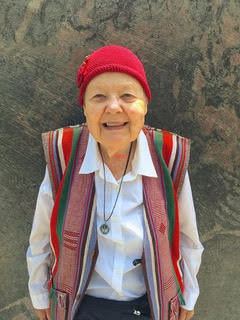
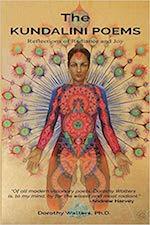
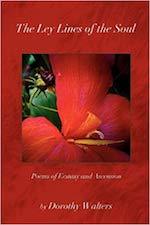
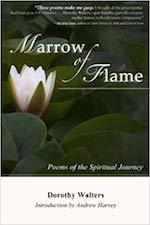

Order Dorothy Walters' Books
The Kundalini Poems: Reflections of Radiance and Joy
Marrow of Flame: Poems of the Spiritual Journey
The Ley Lines of the Soul: Poems of Ecstasy and Ascension
Some Kiss We Want: New and Selected Poems
(using the Amazon links above help to support the Abbey scholarship fund at no additional cost to you)

Dreaming of Stones
Christine Valters Paintner's new collection of poems Dreaming of Stones has just been published by Paraclete Press.
The poems in Dreaming of Stones are about what endures: hope and desire, changing seasons, wild places, love, and the wisdom of mystics. Inspired by the poet’s time living in Ireland these readings invite you into deeper ways of seeing the world. They have an incantational quality. Drawing on her commitment as a Benedictine oblate, the poems arise out of a practice of sitting in silence and lectio divina, in which life becomes the holy text.
[image error]
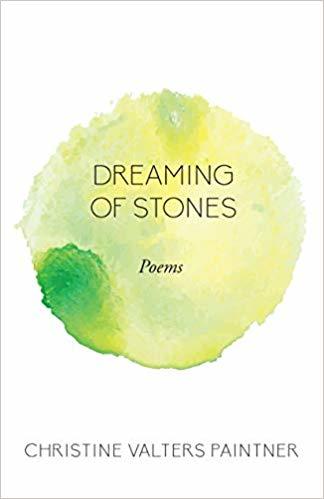
April 13, 2019
Cultivating Eyes of the Heart (Part 2) ~ A Love Note from Your Online Abbess
 Dearest monks, artists, and pilgrims,
Dearest monks, artists, and pilgrims,
Our habitual ways of perceiving the world, which help us navigate things like stopping at a red light or stop sign, also stand in the way of seeing the world in fresh and new ways. So often, we are looking for information, rather than truly seeing.
I find inspiration in the ancient practice of lectio divina, or sacred reading. In lectio, we read scripture and listen for what word or phrase is shimmering. This practice is always in service of contemplative vision in daily life. Lectio invites us to slowly see more and more of the world as a sacred text, ripe with possibility for meaning. We can expand our contemplative practice to include a kind of visio divina, or sacred seeing, where we gaze on an icon or painting we love and look for something that shimmers – perhaps a symbol, a color, a brushstroke, the play of light and shadow. And in that shimmering we know there is a gift for us, even if we don’t fully understand its meaning in the moment.
We can then expand our practice of sacred seeing even further to include what we see all around us in our daily lives. What would it be like to move through our day, watching for what shimmers, waiting to receive these moments of revelation, and then savor them?
A question I often receive from people cultivating the contemplative path is: How do I cultivate trust in what shimmers? How do I know what I am drawn to is sacred?
We are so used to moving through the world analyzing and judging, bringing our expectations to each encounter, planning for the next several steps ahead. It can feel awkward to bring ourselves fully present and draw on intuition, wisdom, and experience, rather than logic and analysis, to see what is most true. This heart-centered knowing comes through practice.
The most essential way I learn to trust what shimmers, is to ask myself if this encounter increases my compassion. Do I feel a sense of expansiveness toward myself and others? When the holy shimmers before us, it is always in the service of greater love.
As I cultivate this practice of attending to the gifts the world has to offer me, to what shimmers, I am at the same time nurturing the opening of my own heart. Our minds harden our defenses, but the heart softens and blooms forth slowly, so that we find ourselves looking with more compassion on those who annoy us, and perhaps later, those we actively dislike, and finally those we have previously ignored and not even allowed into our line of sight.
When we discover ourselves surprised by love and grace, we come to trust what shimmers forth as gift. We receive without needing to figure things out. We begin to follow the thread of moment by moment revelation, not knowing where it leads, only embracing the call to see with eyes of the heart.
(This reflection first appeared in an issue of Weavings journal)
Please join us for our Easter season online retreat when we will practice resurrection through contemplative photography. Details and registration here>>
With great and growing love,
Christine
Christine Valters Paintner, PhD, REACE
Photo © Christine Valters Paintner
April 9, 2019
Monk in the World Guest Post: Anne Marie Walsh
I am delighted to share another beautiful submission to the Monk in the World guest post series from the community. Read on for Anne Marie Walsh's reflection, "Deep Within."
Silent retreats, generally considered "time apart", also point a way for me to be contemplative in the world moment to moment. Sometimes I arrive in exhaustion, feeling there is no time even for this retreat, what was I thinking, how on earth is this going to help? But allowing the sure footedness of the decision to come, now after many such retreats, I know it is a great gift to enter silence so intentionally in a space that honours and prepares for such a way of being together. I trust it and what might be quietly leading me.
Silence seems to open into a space of erasure: even if I bring them, I usually abandon books, screens, speech, plans, projects, even contemplative possibilities like knitting or painting while at the retreat. Especially at the beginning, I find myself walking slowly outside, often stopping, or sitting quietly, in many ways “doing nothing”. One director guided us before the silence, to attend to what is already being offered: to listen for it, to expect to gently, quietly be led to the gift that is already prepared for you in this time apart.
In retreat (but also at home in daily walks, or in sitting in stillness) it means, for me, attending with a kind of soft alertness, letting go of any tendency to control or “work at” composing the time. Slow walking (this is not exercise or fitness), frequent stopping, allows a meditative reception of what is given. The senses are open. Sounds, even of tiny leaf movements, are present to me. My eyes perceive the delicacy of forms, letting them be as they are, no thought, no judgement, no science, no art: just lingering with these manifest things. The scaly bark of trees and shelves of unexpected fungi; the curved crux of black branches; dark hidden spaces and strewn shafts of light down a steep cedar slope; the insect-eaten oak leaf, a skeletal lace. All in their own silence somehow seem to reveal to my silence their infinite variety and fecundity, the hand of great Artistry.
And that shared silence in itself is healing. The slow being-with "things" as they are, softens me, lets me feel the depth of my own being IN the same world, also one of the million forms, alive at the same time, part of some infinite extension of mystery. For what can we say about all of this? What is given exceeds us. It is unsayable and yet we walk in its midst, breathe the same air, unfold into the spacious openness which is always with us, yet so often veiled by our busy preoccupations and cares.
Sometimes a tree (or a flower or a fox) will reveal itself as mystery. The tree can stand, powerful, towering, yet silent and majestic, through hundreds of years, through harsh winters, the dark cold nights, the scorch of long summers. Standing near such a created being, I find my own desire to join the tree, to find a way to be its kin: steadfast, strong, quiet, yielding, beautiful, and patient in slow growth from a deep heart- certainty, true to my given nature. If Nature be our first Scripture, then this hearkening to our deep nature, whether tree or person, is reflected, I think, in our second, written Scripture: “Deep within, I will plant my law. Not on stone, but in your heart.” Deep within , we are already seeded with the life of Life, with our own wild and precious desires which are rooted in the divine urging us into ever more fullness of life.
Deep Within
How can we say what silence and quiet attention reveal to us?
In every moment, we are presented with arrays of some assorted light,
too complicated to name or fully notice.
Yet in an instant we can rest upon a small pointe vierge
and there be born anew,
able to glimpse how we are always raised to some infinity,
We can regard the vastness of our world in a single upside-down reflected sky
in the puddle of a rainy deck’s dark wood.
We are so small, so brief.
The majesty and terror of creation is far beyond our ability to contain.
Yet we are made in such a way that the Infinite dwells in us;
Brief and small, we are made vast
inscribed by the in-dwelling Holy Mystery.
Love, the Heart of All, holds us
even in destruction.
We will say: we did not know what we were doing.
But held, we are held
every leaf proclaims the love in which we are held.
 Anne Marie lives north of Toronto, Ontario in Canada. A painter and writer, she has recently retired from teaching and working within the helping professions. In recent years, silent retreats have sheltered and guided her in accompanying her long-time companion as he experienced the difficult descent into Alzheimer’s disease.
Anne Marie lives north of Toronto, Ontario in Canada. A painter and writer, she has recently retired from teaching and working within the helping professions. In recent years, silent retreats have sheltered and guided her in accompanying her long-time companion as he experienced the difficult descent into Alzheimer’s disease.
April 6, 2019
Vespers (New Poetry Video) ~ A Love Note from Your Online Abbess
Vespers
The sun slides down
the gap between houses
its amber reach crosses the grass
toward me, shadow of the elder tree
has grown long and I remember
under the mulberry spectacle of sky
how everything I love must end:
this cup of tea with steam ascending,
the dog curled right against me,
your warm hands over mine,
how this sweet leaving of day
makes me draw the world
as close as possible.
—Christine Valters Paintner
(*originally published in U.S. Catholic magazine)
Dearest monks, artists, and pilgrims,
The poem above is part of a series of poems I wrote to honor each of the monastic Hours of the day. (You can read the whole series in Dreaming of Stones). Praying the Hours is an essential part of the life of the monk, a way of honoring the unfolding of each day, its sacred ordinariness, and a return again and again to the presence of the divine right in this moment.
Years ago I discovered the book Music of Silence by Benedictine monk David Steindl-Rast, which is a beautiful and poetic exploration of the gift of the Hours. In it he invites us to consider the invitation each Hour of the day calls us into. Dawn reminds us of the gift of awakening, midday to fullness, evening to the sweetness of endings, and night to mystery and silence. This book had a significant impact on my own prayer, work, and thinking. Whether or not you pray the Hours in a formal way with the Psalms, you can pause at these thresholds and wonder at what new awareness you are being called to.
Dawn and dusk are considered threshold times in the Celtic imagination. The veil is especially thin at these moments and the Otherworld more accessible. What a gift it is to be present at the glory of a sunrise or sunset and to feel your heart come alive to the staggering beauty of the world.
In the monastic tradition another essential practice is memento mori, or remembrance of one’s own death. “Keep death daily before your eyes” wrote Benedict in his Rule. The desert mothers and fathers repeat this again and again in their wisdom sayings. When we draw close to the reality of our mortality, we are reminded again and again of how everything in our lives is gift. When I was forty I had a pulmonary embolism after a long-haul flight to Europe and in the days following my diagnosis and treatment, I wasn’t regretting not having traveled more or done more in the world. What I longed for were the simplest of things like the warmth of John’s hand in mine, the delight of our dog’s nearness. I would sit with a cup of tea grateful simply for the gift of presence.
I have another poem video for you this week, created again by Luke Morgan of Morgan Creative. This time he appears as the man in the video, so you can have a peek at the creative mind behind this series. I encourage you to pour yourself a cup of tea and read the poem above, then watch the video and see what is stirred in your own heart. When you ponder your own mortality what are the gifts you immediately want to treasure?
You can order your copy of Dreaming of Stones. I’d be so grateful if you’d consider posting a review to Amazon.com and Goodreads! It helps authors so much in getting their book seen by a wider audience.
My poem “Miriam on the Shores” was featured in Paraclete Press’ daily email newsletter for national poetry month. You can read the poem here>>
Want to dive into sacred poetry with me in Chartres, France? Join me June 10-14, 2019 for a transformative week of reading and writing poetry together (no experience necessary) and the chance to walk an ancient labyrinth. Step onto the threshold where new possibilities beckon. Register here>>
With great and growing love,
Christine
Christine Valters Paintner, PhD, REACE
Photo © Christine Valters Paintner
April 2, 2019
Featured Poet: Laurie Klein
We are launching a new series this spring with poets whose work we love and want to feature!
Our next poet is Laurie Klein whose work is deeply inspired by mystery and the healing that comes from courting holy disruption. You can hear Laurie reading her poem "How to Live Like a Backyard Psalmist" below and read more about the connections she makes between poetry and the sacred.
https://abbeyofthearts.com/blog/wp-content/uploads/2019/03/Backyard-Psalmist.mp3
How to Live Like a Backyard Psalmist
Wear shoes with soles like meringue
and pale blue stitching so that
every day you feel ten years old.
Befriend what crawls.
Drink rain, hatless, laughing.
Sit on your heels before anything plush
or vaguely kinetic:
hazel-green kneelers of moss
waving their little parcels
of spores, on hair-trigger stems.
Hushed as St. Kevin cradling the egg,
new-laid, in an upturned palm,
tiptoe past a red-winged blackbird’s nest.
Ponder the strange,
the charged, the dangerous:
taffeta rustle of cottonwood skirts,
Orion’s owl, cruising at dusk,
thunderhead rumble. Bone-deep,
scrimshaw each day’s secret.
Now, lighting the sandalwood candle,
gather each strand you recall
and the blue pen, like a needle.
Suture what you can.
Appeared in Where the Sky Opens
Themes of Her Work
I’m currently thinking of poems as Valentines. I want to name what I love in ways that startle and disrupt and heal. I chase economy with ruthless reverence: a few memorable details, a singular question, the felicitous jolt. Perhaps I’m courting revelation, dazzle amid what dissolves. Feeling compelled by what I can sense— but not say—never stops me from trying! Yes, I trip over my own words, then, eventually, hopefully, cajole all my striving toward tenderness, wherein I can kneel, re-graced. Hostage to nothing. And there, await the passing sacred hem, linen’s whisper brushing against my hand.
Poem for Epiphany
Perhaps, rolled in papyrus
or raw silk,
the jeweled boxes arrive as small thuds,
and gifts imprint the dirt floor.
Were the Magi
quiescent?—a hint of Quaker,
a nod to Zen—with nothing
verbal to treasure or
ever replay in their minds
save eloquent exhalations,
the creak of joints,
be they camels or kings,
the serial tick of straw.
For the marveling patience
of plastic wise men
en route, step-by-step,
to my mother’s crèche (despite
my down-the-stairs drop kicks,
behind her back), I reposition
my knees, atoning, wordless
now, as the star comes for me.
Appeared in Books & Culture, 2016
Poetry and the Sacred
For me, entering the presence of the sacred means embracing mystery. And I adore mystery. Poems I love evoke—and expose—irresistible gaps: within my understanding, between the lines themselves, betwixt soul and Truth’s unerring glance. So I try to inhabit a listening simplicity that borders on innocence, nose out clues. Heaven knows, the last word on just about everything still remains to be said. Often, as a gap narrows into connection, an insight arcs—a comet searing my meager horizon. Is it any wonder “scared” and “sacred” share the same letters?
Centuries ago, trembling Magi parsed the star’s mysterious invitation. The seeking, the gazing, the giving—historically, we call this Epiphany: literally, “to show, to make known, to reveal.” And aren’t these the riches poems offer? An unexplained image shimmers, one step or seemingly light years beyond our reach. We turn toward it, and the primed heart, the even more primal gaze, kindles a devotional reset. Reverence radiates. Gregory Boyle, S.J. tells us, “Awe softens us for the tender glance of God,” which, in turn, graces our glance at life’s enigmas: the sacred waiting for us within others, ourselves, and our work.
I Dream You Ask,
But Where Do I Start?
Unglove the knuckles,
torqued and sore. Let the flesh
dip, then lift, a hand dripping
tears, into the basin,
anchored within a pillar of stone.
Such a kindness, this water,
warmed. Sketch the sign: brow
to breastbone, then shoulder
to shoulder—a recollection,
retraced, like a map. Tell me,
which is graver: the soul's
relief, or its grateful receipt,
re-initialed? Love is an oar
extended, until the lapsed
skiff of a self,
long swamped,
resurfaces chaste, borne
on a christening tide where
memory balloons, everything
new, in one killing swirl

About Laurie
Laurie Klein’s work has appeared in numerous journals, anthologies, hymnals, recordings, and recently, on NPR. A past recipient of the Thomas Merton Prize for Poetry of the Sacred and two-time Pushcart nominee, she writes from America’s Inland Northwest. Where the Sky Opens is her debut collection (The Poiema Poetry Series), available at Wipf & Stock (always 20% off retail), and Amazon.Visit Laurie Klein on Facebook, or sample her bimonthly blog at LaurieKleinScribe.com
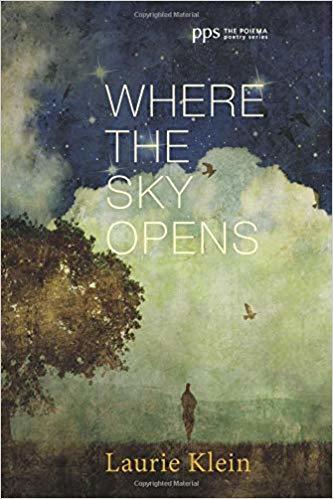

Photo by Dean Davis Photography
Order Laurie Klein's Book
Where the Sky Opens: A Partial Cosmography (The Poiema Poetry Series)
(using the Amazon links above help to support the Abbey scholarship fund at no additional cost to you)

Dreaming of Stones
Christine Valters Paintner's new collection of poems Dreaming of Stones has just been published by Paraclete Press.
The poems in Dreaming of Stones are about what endures: hope and desire, changing seasons, wild places, love, and the wisdom of mystics. Inspired by the poet’s time living in Ireland these readings invite you into deeper ways of seeing the world. They have an incantational quality. Drawing on her commitment as a Benedictine oblate, the poems arise out of a practice of sitting in silence and lectio divina, in which life becomes the holy text.
[image error]

March 30, 2019
Cultivating Eyes of the Heart (Part 1) ~ A Love Note from Your Online Abbess
 Dearest monks, artists, and pilgrims,
Dearest monks, artists, and pilgrims,
The Gospels are filled with stories about seeing, or not seeing, as the case may be. On the road to Emmaus the disciples are walking with Jesus and breaking bread with him. We read that their “eyes were prevented from recognizing him.” (Luke 24:16) When Jesus returns in resurrected form, he is fully embodied, yet hard for them to see clearly. The disciples do not expect their dear friend to be among them again and so they miss this truth with their limited vision.
We find a similar emphasis on vision in the story of Jesus’ Transfiguration. The burning light that once appeared to Moses in the bush now radiates from Jesus himself: “His face shone like the sun.” For the ancient writer Gregory Palamas, it was the disciples who changed at the Transfiguration, not Christ. Christ was transfigured “not by the addition of something he was not, but by the manifestation to his disciples of what he really was. He opened their eyes so that instead of being blind they could see.” Because their perception grew sharper, they were able to behold Christ as he truly is.
This speaks of an invitation to see the world in a different way. When we rush from thing to thing, never pausing, never allowing space, we see only what we expect to find. We see to grasp at the information we need. We see the stereotypes embedded in our minds. We miss the opportunity to see beyond what we want. We walk by a thousand ordinary revelations every day in our busyness and preoccupation.
We move through our lives, often at such speed, that our perception of time becomes contorted. We begin to believe that life is about rushing as fast as we can, about getting as much done as possible. We are essentially skating across life’s surface, exhausted, and disoriented.
The World Breaks In
You may have had an experience where you are moving through a most ordinary day, when suddenly something shifts. Where there was drudgery and habit, suddenly you become aware of the way sunlight is spilling across the living room rug and your heart breaks open at the splendor of it all. Or you see a loved one in a new way and revel in their beauty. Or maybe it is as simple as savoring the steam rising from your morning coffee like incense lifting the longings of your heart.
Contemplative practice calls us to change our perspective and awaken to a different reality, one that is governed by spaciousness, slowness, stillness, and presence. Contemplation invites us to tend the moments and see what is there, rather than what we expect.
Moments are holy doorways where we are lifted out of time and we encounter the sacred in the most ordinary of acts. Moments invite us to pause and linger because there is a different sense of time experienced. Moments are those openings we experience, where time suddenly loses its linear march and seems to wrap us in an experience of the eternal.
We are called to open ourselves to these moments of eternity, or better yet, how we allow the moment to find us. We only need to make ourselves available to them, to receive them as the gifts that they are, rather than seek them out as something we are entitled to have.
(This reflection first appeared in an issue of Weavings journal)
Please join us for our Easter season online retreat when we will practice resurrection through contemplative photography. Details and registration here>>
With great and growing love,
Christine
Christine Valters Paintner, PhD, REACE
Photo © Christine Valters Paintner
March 26, 2019
Monk in the World Guest Post: Beverly Dame
I am delighted to share another beautiful submission to the Monk in the World guest post series from the community. Read on for Beverly Dame's reflection on living by and leaving the river.
For five years, I lived on the bank of a small Canadian river. For someone who had always been a city-dweller even as a child, it was rather like being at camp twelve months a year. The river’s calm waters led us to name our cottage “Stillwaters” because like the psalmist God had led us to them.
The seasons were read on the face of the river. On the coldest days, it froze from bank to bank. In the spring, the snow melt and rain meant rushing to put rocks on the dock so it would not float away. There were the annual comings and goings of geese, the first sighting of their goslings, and then the flocks loudly heading south.
During those years I began a daily ritual. Soon after dawn I would take my camera to the water’s edge to capture the light and color of the moment. Sometimes it was the pinks and violets and golds of the sunrise. At others, it was the shades of white as a fog danced on the surface. It was art and meditation, a spiritual exercise as well as a creative outlet.
It was at the nearby Abbey of St. Benoit du Lac that I became interested in formally observing the hours of the monastic day, to combine prayer with work and the rest of life. It was a routine that seemed to offer something more than the pattern of my childhood Protestantism. For the monks at the Abbey prayer and worship. They were knit into each day, not confined to Sunday morning.
This was not my first introduction to the monastic life. As with many women of my generation, I had been captivated by the struggles of Audrey Hepburn’s character in “A Nun’s Story.” In college, I had been fascinated by the lives of the desert mothers, by St. Francis, and by Thomas Merton’s “Seven Story Mountain.” I met my husband at a silent retreat at the convent of All Saints Sisters of the Poor in Catonsville, Maryland.
As an introvert, the idea of the monastic life has always had great appeal. In a romantic haze it is easy to forget that for monks and nuns taking the habit means living in community not isolation. The challenge is to combine a spiritual life with a temporal one; contemplation with action, to be in one place while growing.
In our years on the river I added to the discipline of my morning photography session with 20 minutes of centering prayer. Frequently my husband and I would drive to the Abbey for vespers or the noon mass. On line I discovered the Holy Disorder of Dancing Monks and the daily meditations of Fr. Richard Rohr, founder of the Center for Contemplation and Action.
That life ended in early 2016 when my husband was diagnosed with COPD (Chronic Obstructive Pulmonary Disorder). He tried to adjust but after three months of a northern winter he found it difficult to breathe indoors or out so we put our riverside home on the market. The fact that it sold in three weeks affirmed our decision to move South.
Between the decision and the actual move, chaos reigned. Each item we touched from plates to paintings, from a lawn mower to my knitting stash required a decision: keep, pitch, donate. The routine of photography/prayer/meditation too often slipped from habit into a good intention.
In the eighteen months since our move to the Gulf Coast of Florida I have often felt like one of the cattails from our riverbank, yanked by my roots and planted in a very different place. Not only am I not beside the river, but the world seems upside down. Summer is the time you stay indoors to escape the heat and humidity not as in the north country where you are outside as much as possible. Winter is the gentle climate not the season of snow and ice Geese and ducks have been replaced by ibis and herons, pelicans and seagulls; maples by palm trees; wool socks and boots by sandals; our family of muskrats by an alligator named Elvis.
Slowly I am bringing back the rhythm of my spiritual life. While I sometimes skip my twenty minutes of meditation, I am anchored in the worldwide community of the Internet. My morning begins with thoughts from the Abbey of the Arts and Fr. Richard Rohr’s meditation. Sometimes I dip into a daily devotional from the United Church of Christ and listen to Morning Prayer from the Mission of Saint Clare. Emails and Facebook posts from friends still on my patch of river keep me updated on their lives. Winter brings the Canadian snowbirds and cans of maple syrup. The discipline of writing, including this meditation, is returning.
And, I am finding a new group of people on the path. Our church has a contemplative prayer group, more than 100 individual opportunities for service as well as daily celebrations of Holy Eucharist.
To borrow the cliché, life is definitely a journey, and not a guided tour. What the past few years have taught me is that the journey can be informed by a framework of prayer and meditation, exploration and discipline, wonder and acceptance. I can be a nun but a nun in the world.
 Beverly Dame is a retired communications professional who now lives on the bank of a small lake in Sarasota, Florida. Her photos and writing can be found at A Woman of Enthusiasms.
Beverly Dame is a retired communications professional who now lives on the bank of a small lake in Sarasota, Florida. Her photos and writing can be found at A Woman of Enthusiasms.



